Art World
7 Legendary Mistresses in Art History
Portraits of kept women by George Romney, William Holman Hunt, and others.
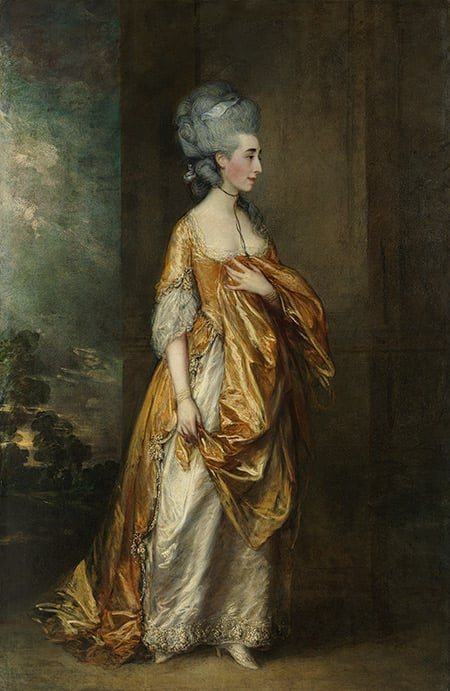
Portraits of kept women by George Romney, William Holman Hunt, and others.

Graham Fuller

A collection of paintings depicting kept women and mistresses may raise eyebrows since it implies a celebration of female sexuality as a commodity. That is not our intention. The works below offer a range of perspectives on the experience of maintaining a relationship with men who, for whatever reasons, find it convenient to pay for sex. Some of these women are regretful, some are empowered—in complete control of their circumstances. And one of them has just realized that she is going to break free and live her life on her own terms—society permitting, of course.
William Holman Hunt, The Awakening Conscience (1853).
The most famous Victorian morality painting captures the moment when a young woman realizes that she’s ruining her life being kept, in nouveau-riche clutter, by her complacent lover. Hunt drew inspiration from Daniel Peggotty’s search for his niece Emily after she runs off with the seducer Steerforth in David Copperfield. The love nest in the Pre-Raphaelite work is crammed with symbols of the mistress’s entrapment— including a cat tormenting a bird and a clock under glass that indicates stopped time. Hunt’s fiancée, Annie Miller, was about 18 when she sat for the painting; they parted acrimoniously before they could marry. The male sitter may have been the artist Augustus Egg. His 1858 morality painting Past and Present—a triptych depicting the sundering of a family because of the wife’s adultery—was inspired by Hunt’s.
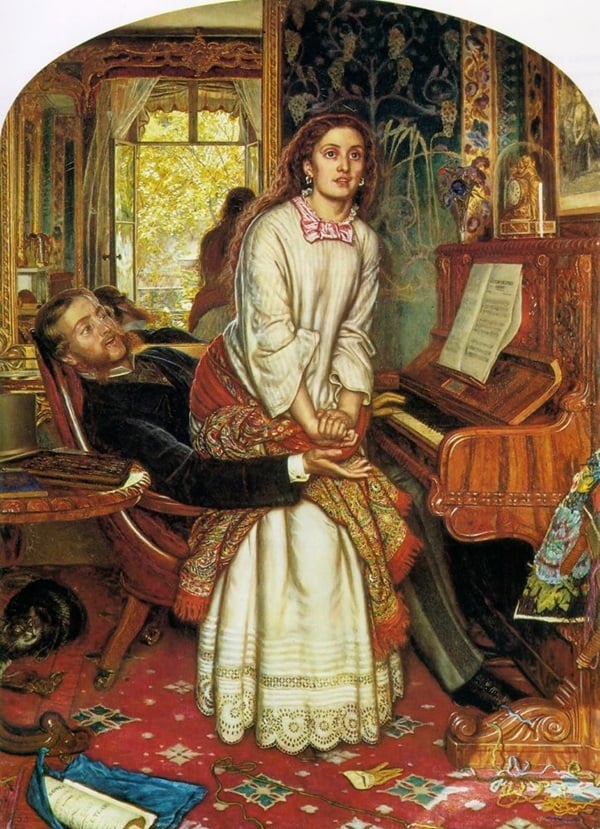
William Holman Hunt, The Awakening Conscience (1853)
Photo: Public domain.
Hans Makart, Marble Hearts (circa 1880).
The Austrian academic history painter Makart, famed for his aestheticism and known as “the magician of colors,” was the dominant figure in the Viennese art world of the 1870s. His portraits of high-society ladies were often tastefully sensual, his mythical paintings more blatantly erotic. Klimt revered him. The key to understanding this painting of two languid femme fatales—whose luxurious lifestyle is not attributable to hard work and honest endeavor—is the malicious overstuffed cat perched on the pillow behind the fair woman’s head.
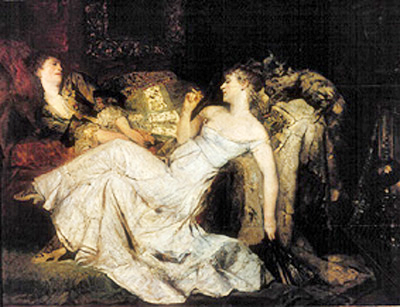
Hans Makart, Marble Hearts (1880).
Photo: Museum Syndicate.
Tukioka Yoshitoshi , Looking Itchy – The Appearance of a Kept Woman of the Kansei Era (1789-1801) (1888).
The 19th century Japanese took pride in deciphering character traits from facial features. They would have been able to tell—more easily than contemporary Western art-lovers—the mindset of this voluptuous concubine drowsily emerging from a mosquito netting in a state of post-coital disarray. Number 16 in Yoshitoshi’s “Thirty-Two Aspects of Customs and Manners” series, the exquisitely nuanced “Looking Itchy” demonstrates his mastery of the Uyiko-e genre of woodblock printing and painting.

Tukioka Yoshitoshi, Thirty-Two Aspects of Customs and Manners, Looking itchy: The Appearance of a Kept Woman of the Kansei Era (1789–1801) Number 16 (1888), Oban.
Photo: Toshidama Gallery.
Ivan Kramskoi, Unknown Woman (1883).
A woman in her early 20s sits alone in a carriage in a Russian city lightly dusted with snow. Her clothes are fine, as is her blue-ribboned muff and her white-feathered hat. She wears red lipstick and a gold bracelet (possibly two) on her left wrist. She has been painted from a slightly low angle, which emphasizes the downwardness of her direct gaze, as her narrowly lidded eyes emphasize her haughtiness. The expression has long fueled speculation that the sitter was a woman who had risen in society by selling her favors to a wealthy man—or does that amount to a slur on the reputation of a virtuous young bourgeois who thinks rather too much of herself? A leader of the Russian democratic art movement of 1860–80, Kramskoi championed clarity, humanism, and psychological realism. He painted peasants as well as imperious city girls.
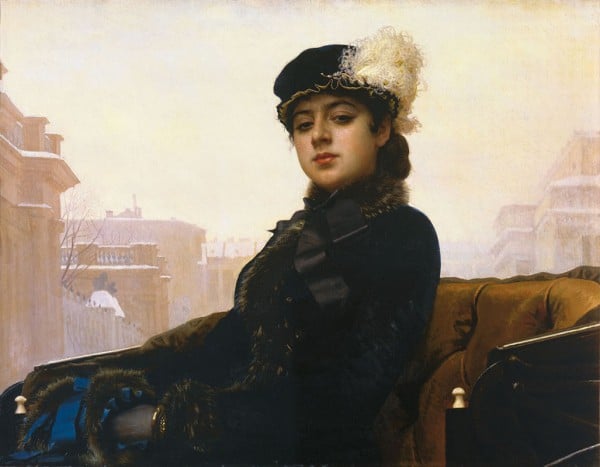
Ivan Nikolaevich Kramskoi, Portrait of a Woman (1883).
Photo source: Public domain.
Raimundo de Madrazo y Garreta,The Reluctant Mistress (date unknown).
Madrazo (1841–1920), the technically brilliant Spanish genre painter, was taught by his father, the historical artist Federico de Madrazo y Kuntz, and influenced by his brother-in-law, Fortuny. His witty, elegant portraits capture in rich color the ease and frivolity of bourgeois existence. Aline Masson, the mistress he painted obsessively, sat for this unusual painting, which perhaps reflects her own feelings about her married lover. A mistress has received a bunch of flowers and a letter from the man who has recently left her rumpled bed. Her sense that she is being used is palpable.
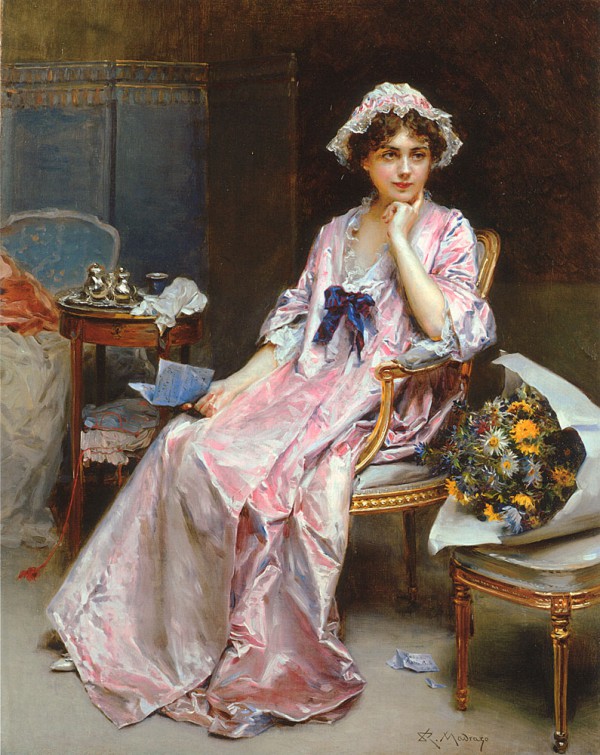
Raimundo de Madrazo y Garreta, The Reluctant Mistress (date unknown).
Photo: Public domain.
George Romney, Emma Hart as Circe (circa 1782).
A serial kept woman, the vivacious Emma Hart would become the mistress of Lord Nelson in 1798 or 1799. If that was her most famous role, she also shone as the creatively involved muse of Britain’s most fashionable portrait painter of the day. She sat for Romney over a hundred times, their sessions resulting in some sixty paintings. She was 17, already an accomplished adventuress, when she posed as the mythological enchantress Circe. Romney’s brushwork captures the luxuriousness of Emma’s famous auburn hair; her expression of surprise is emphasized by the half shadow on the left side of her face.
Hart was married to Sir William Hamilton, the British ambassador to Naples, when she first met Nelson in 1893. She was a celebrity hostess and poser of classical “attitudes,” and he was the national hero, recent conqueror of Napoleon’s fleet at the Battle of the Nile, when their affair began. It produced a scandal and their daughter Horatia, and lasted until Nelson’s death at Trafalgar in 1805. The establishment wrote her out of his history. She died impoverished in Calais in 1815.
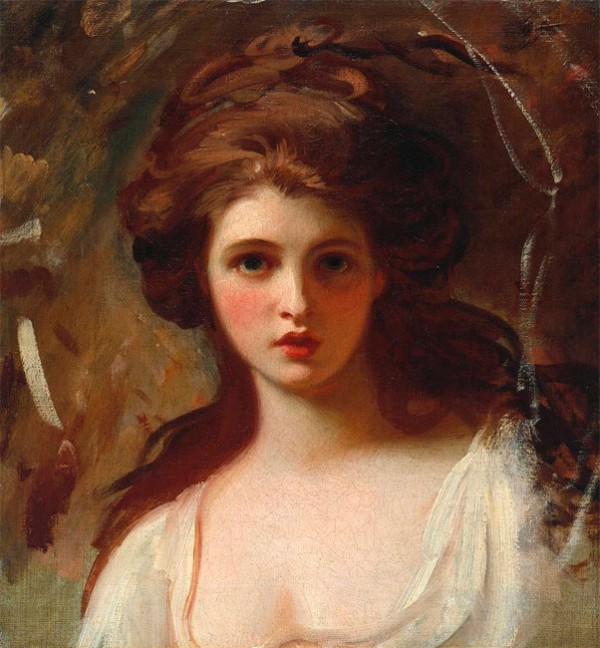
George Romney, Emma Hart as Circe (circa 1782).
Photo: Tate.
Thomas Gainsborough, Portrait of Grace Elliott (circa 1778).
The scandalous early career of the Scottish socialite and royal courtesan Grace Dalrymple Elliott (1758–1823) would have made a rollicking Fielding or Richardson novel. It involved teenage adultery, her kidnapping by her brother, and numerous liaisons with powerful men. The Prince of Wales, later George IV, possibly fathered her daughter. Gainsborough painted this portrait and a full-length study of the patrician beauty when she was about 20.
A decade later she was witnessing the French Revolution. Whereas Grace was a monarchist, her onetime lover Philippe Duke d’Orléans was a Jacobin who sought the king and queen’s executions. Despite Philippe’s Republican allegiance, he himself was guillotined as a Bourbon in 1793. Grace was imprisoned but survived the Terror. Napoleon allegedly proposed to her. She died in 1823, the rich mistress of the mayor of Ville-d’Avray. Lucy Russell played her in Eric Rohmer’s tense costume drama The Lady and the Duke (2001), based on her untrustworthy Revolution memoir.

Thomas Gainsborough, Portrait of Grace Elliott (circa 1778).
Photo: The Metropolitan Museum of Art.